Reggiane
Re 2005 Sagittario
Re 2005R
Re 2005 Bifusoliera

ReggianeRe 2005 Sagittario Re 2005R Re 2005 Bifusoliera |

|
The Reggiane Re 2005 Sagittario was the ultimate refinement of a series of Italian fighters which started with the Re 2000 Falco I and continued with the Re 2001 Ariete I and Re 2002 Ariete II. The Re 2003 was a reconnaissance variant of the Re 2000, and the Re 2004 was an unbuilt proposal with the troublesome 1,250 hp Isotta-Fraschini Zeta RC 24/60 24 cylinder X-type engine. The Sagittario utilized a much-refined fuselage, a wing of new design, and outward-retracting landing gear.

Reggiane Re 2001 Falco II. |

The radial-engined Re 2002 Ariete II, |
Design was initiated in 1941 by Ing. Roberto Longhi, and the Sagittario was to be the final Reggiane design to fly. Construction of the first of two prototypes, MM494, was completed in December 1941, minus the German-supplied Daimler-Benz DB 605A engine, which vanished in transit, finally being found at a rail station in Milan in April 1942! Upon installation of the powerplant, MM494 was readied for its first flight. Sources vary as to the exact date of this event. However, several days before the official flight, the craft took to the air with Tullio de Prato piloting. The flight was apparently uneventful until he prepared to land, whereupon it was discovered that one of the main landing gear legs was not locked in place. De Prato promptly retracted the gear and made a belly landing, with the prototype amazingly suffering no damage. The official first flight was made several days later. The aircraft was evaluated over the course of several months and performed ably, but only the protoypes and a 16-aircraft zero series had been ordered by the end of 1942, all of which were hand-built by Reggiane. By February 1943, 18 pre-production and 750 production Re 2005's had been ordered by the Italian Aeronautics Ministry. The possibility of up to 1,000 more aircraft being built was considered, with Breda, Aerfer and Caproni as second-source manufacturers. Sweden also was interested in procuring rights to build the Sagittario under license, but the 1943 Armistice halted these plans.
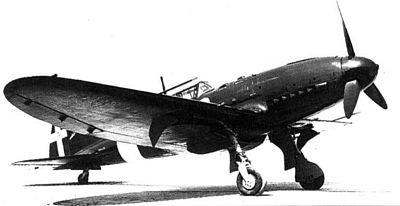
In May of 1943, the first Sagittarios entered limited service with the Regia Aeronautica. The first prototype and several of the zero series aircraft were used operationally by the 362a Squadriglia, 22o Gruppo at Naples-Capodichino starting in May 1943, being used to defend Rome and Naples. On July 10, eight of the aircraft were transferred to Sigonella to defend against the Allied invasion of Sicily. Only two aircraft survived, which then went to the 371a Squadriglia at Reggio Calibria. These aircraft were soon destroyed on the ground by Allied aerial attacks. The strength of 362a Squadriglia was increased with the addition of ten pre-production Sagittarios in July 1943. The squadron had developed a rather daring method of attacking Allied B-17s which involved diving head-on with all guns blazing, then flipping the aircraft over on its back and diving away at the last minute.
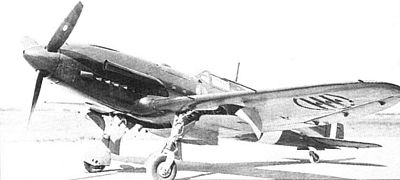
At the time of the Armistice, the zero series and 13 of the 18 pre-production aircraft were completed, with work proceeding on the first production aircraft. Only two aircraft remained with the 362a Squadriglia, neither of which was in flying condition. Both were burned to prevent capture by the Allies. The two protoypes and 11 of the pre-production aircraft were taken to Germany, possibly being used to defend Bucharest and Berlin; their fate thereafter being unknown. At least one Re 2005 was captured by the U.S., and the fuselage of one Re 2005 survives in the Museo Aeronautico Caproni di Taledo in Milano.
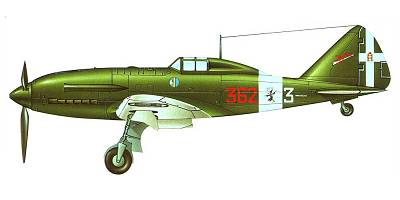
While the Re 2005 was the last fighter built by Reggiane to fly, it was not Reggiane's last project. A twin-fuselage variant of the Re 2005 was proposed but almost immediately abandoned. Another proposal, the Re 2005R, would have had an extra 370 hp Fiat A-20 engine in the tail driving two superchargers, one for the primary powerplant and the other providing exhaust thrust at the tail. However, similar performance could be obtained with less complexity by installing the more powerful 1,750 hp DB 603A, which is precisely what was planned for the Re 2006. Two airframes (serials MM540-541) were being built in 1943 - 1944. The first was completed but never flown, and was given to the Milan Polytechnic after being made unflyable: the engine, armament and landing gear were removed and the fuselage and wings were cut in two. It is alleged by some sources that the second Re 2006 was converted to become the basis for the jet-powered Re 2007. It was purportedly halfway finished and was awaiting arrival of German-supplied Junkers Jumo 004 B turbojets, which never arrived due to the end of the war. It was taken by the Allies, along with the plans, in July 1945. Further research shows that this most likely was not the case, and the Re 2007 was more of a post-war attempt at keeping Reggiane alive as an aircraft builder. Fewer Re 2005s were built than its contemporaries, the Macchi C.205 and Fiat G.55, both of which achieved some post-war success. This, along with the advent of the jet age, ensured that the Re 2005 did not see any further development post-war.
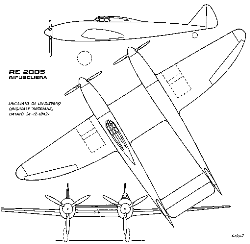
Timeline
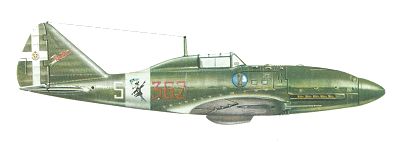
| Specifications | Design A05/0901 (theoretical) | Re 2005 |
| Designer(s) | Ing. Giuseppe Maraschini | Ing. Roberto Longhi |
| Mission Type | Fighter | Fighter |
| Powerplant | (prototypes) 1 x 1,475 hp Daimler-Benz DB 605A-1 V-12 inline | 1 x Fiat RA.1050 RC 58 Tifone inverted-V-12 liquid-cooled inline; 1,475 hp @ take-off, 1,355 hp @ 18,700 ft (5,700 m) |
| Dimensions | ||
| Span | -- | 36 ft 1 in (11 m) |
| Length | -- | 28 ft 7 in (8.73 m) |
| Height | -- | 10 ft 4 in (3.15 m) |
| Wing area | -- | 219.58 sq ft (20.4 m2) |
| Weights | ||
| Empty | -- | 5,732 lb (2,600 kg) |
| Loaded | -- | -- |
| Gross | -- | -- |
| Max | -- | 7,960 lb (3,610 kg) |
| Performance | ||
| Max speed | 345 mph @ 6,560 ft (556 km/hr @ 2,000 m) 367 mph @ 13,120 ft (590 km/hr @ 4,000 m) 384 mph @ 19,685 ft (618 km/hr @ 6,000 m) 400 mph @ 23,622 ft (644 km/hr @ 7,200 m) |
351 mph @ 13,120 ft (565 km/hr @ 4,000 m) 421 mph @ 22,965 ft (678 km/hr @ 7,000 m) |
| Cruise speed | -- | 320 mph (515 km/hr) |
| Stall speed | -- | (Flaps down) 85 mph (136 km/hr) |
| Time to 6,560 ft (2,000 m) | 1 min 35 sec | 1 min 55 sec |
| Time to 13,120 ft (4,000 m) | 3 min 29 sec | 4 min 28 sec |
| Time to 19,685 ft (6,000 m) | 5 min 31 sec | 5 min - 7 min 25 sec |
| Time to 26,247 ft (8,000 m) | 7 min 56 sec | -- |
| Time to 32,808 ft (10,000 m) | 11 min 56 sec | -- |
| Service ceiling | 39,370 ft (12,000 m) | 37,730 ft (11,500 m) |
| Range | 777 miles @ 320 mph (1,250 km @ 515 km/hr) | 609 miles (980 km) |
| Endurance | 2 hr 24 min @ 320 mph @ 21,325 ft (515 km/hr @ 6,500 m) | -- |
| Armament | -- | |
| Crew | One | One |
| Users | -- | Italy, Germany |
| Number built | Two prototype, one static test | 16 Serie 0, 13+ pre-production, small number of Serie I production |
| Construction Numbers | ? | ? |
| Serial Numbers | Prototypes: MM494, MM495 | Serie 0: MM092343-092358 Pre-production: MM096100 - 096117 Serie I: unknown |
| Test Pilots | MM494 first flight: Tullio de Prato | -- |
Additional Information
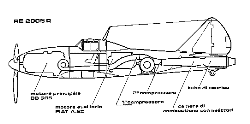
Re 2005R proposal with extra 370 hp Fiat A-20 auxiliary engine driving two Campini superchargers.
Via Max Cappone
Web Links
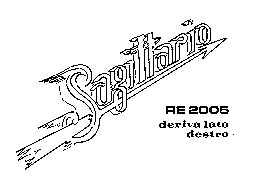
Tail logo
Via Max Cappone
Sources
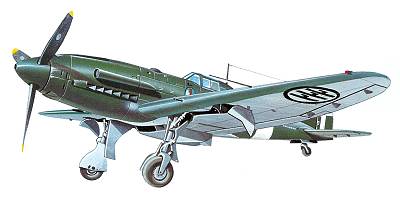
| [ | Home | | | About | | | Contact | | | Top | ] |
© 1997-2005, Robert Beechy
http://fire.prohosting.com/uncommon/aircraft/re2005/index.html
Originally posted 3 May 1998
Modified: 09/14/2006